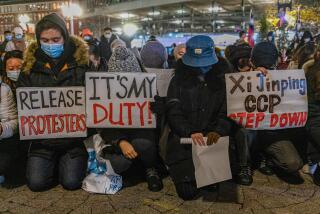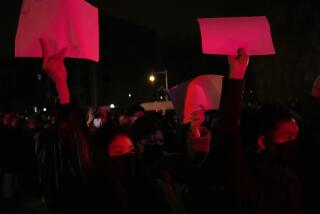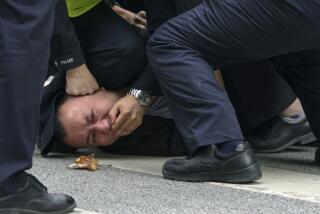Tibet Crowds Riot in Capital for 2nd Day
BEIJING â Pro-independence rioting rocked the Tibetan capital of Lhasa for a second day Monday, with angry crowds rampaging in the streets and security forces shooting demonstrators, killing at least one.
Several thousand Tibetans took control of the old quarter of the city in the morning, according to Western tourists reached by telephone from Beijing. The protesters erected barricades near areas where a fierce clash Sunday left at least 11 dead.
Rioters ransacked Chinese-owned stores Monday and attacked ethnic Chinese who entered the area, but police held their fire until late afternoon, Western witnesses said. Shortly after 5 p.m., however, they began shooting, and firing continued throughout the evening, according to the tourists. Gunshots could be heard in the background during some of the telephone interviews with Beijing reporters.
The official New China News Agency reported early today that one rioter was killed and six wounded in Mondayâs violence, while two police officers were injured. But Western tourists in Lhasa said that number appeared too low.
An American tourist from New Orleans said he was aware of two incidents in which a total of four to 10 Tibetans appeared to have died. Another tourist said he had heard reports of up to seven people killed. Many of those interviewed declined to give their names because of concern about the reaction of Chinese authorities.
Gunfire Heard
Shortly after 5 p.m., the New Orleans tourist said, he heard gunfire near the downtown Jokhang Temple, the site of Sundayâs demonstration. He soon met Tibetans who indicated by body gestures that two people had just been shot to death. He was later told by other Tibetans that six people had been killed, he said.
âShortly after 8 oâclock, a group of about 50 demonstrators started stoning a building next to the Barkhor Cafe,â he added. âThe police shot at them with automatic weapons.â
Other foreigners reported that two to four people died in that clash, he said.
Several tourists also said they believed that Sundayâs casualty toll--reported by Chinaâs state-controlled media--of 10 Tibetans and one police officer killed was too low.
âThe numbers (of estimated dead Sunday) range wildly, but the ones that seem accurate are 30 dead, maybe 40 dead, and more than 100 wounded,â the New Orleans man said.
Doctors at a hospital in Lhasa reached by the Associated Press said they believed 20 to 30 people died Sunday.
China places severe restrictions on access to Tibet by Beijing-based correspondents, refusing most requests to visit but occasionally allowing a few reporters into the region. Tourists are allowed in if they sign up with tour groups.
China has firmly controlled Tibet since 1951. The region was part of the Chinese empire during the Qing Dynasty. But it had de facto independence after 1911, and pro-independence sentiment remains strong.
This month is the 30th anniversary of an abortive anti-Chinese uprising that led the Dalai Lama, traditionally the temporal and spiritual leader of Tibet, to flee to exile in India.
The current violence is the fourth eruption in Lhasa in 18 months that have been suppressed with bloodshed.
From his home in exile in New Delhi, the Dalai Lama appealed to world leaders to help stop the violence. According to the Reuters news agency, his office said he had sent telegrams asking for help in persuading Chinese leaders âto stop the continued violations of human rights and find an early solution to the deteriorating situation in Tibet.â
The secretariat did not specify to whom the telegrams were sent.
In Washington, the United States protested the action. âWe deplore the violence, and particularly the use of weapons, that has apparently resulted in numerous deaths and injuries,â State Department spokesman Charles Redman said.
He said the State Department has not yet formally raised the issue of Tibet with Chinese officials since the latest violence flared, although it is expected to do so.
Several of Mondayâs protest marches, each numbering from 50 to several hundred people, were headed by demonstrators carrying one-foot-square photographs of the Dalai Lama, witnesses said.
âThe streets are thick with people,â said an Australian tourist who spoke in the afternoon with a reporter in Beijing. âThereâs lots of whooping and shouting and throwing stones. Thereâs no control whatever.â
The crowds repeatedly attacked ethnic Chinese who entered the Tibetan quarter, dragging some from their bicycles and beating them, according to Western witnesses.
âTheyâd throw a bunch of rocks at him, get him off his bicycle, throw the bicycle in a bonfire and chase him away in a hail of stones,â said the New Orleans man. âThey were not trying to kill anybody. They were trying to scare them and rough them up a little.â
Another American said he saw a police officer dragged from his bicycle and chased down a street by knife-wielding attackers. The New China News Agency also reported that an officer was among the cyclists attacked. âWhen the policeman stopped, the rioters surrounded him and tortured him,â the news agency said.
The New Orleans tourist said that the mood of the protesters Monday seemed different from the day before.
âYesterday was a kind of heroic, suicidal stand against the Chinese,â he said. âThey showed a lot of courage. . . . Today, the Chinese pulled out (until late afternoon) and it was just vandalism. But it was vandalism with a theme. They were attacking Chinese.â
TIBET: 18 MONTHS OF UNREST
The violence that has rocked Tibet for two days is the latest in a series of anti-Chinese riots that began in 1987. Some of the major disturbances:
October, 1987--Thousands of Tibetans, including many Buddhist monks, clash with Chinese police over several days; as many as 14 people die.
March, 1988--At least eight people die and hundreds are injured, including many police officers, in capital of Lhasa.
December, 1988--Police open fire on crowd of protesters in Lhasa, killing a Buddhist monk and wounding 13.
More to Read
Sign up for Essential California
The most important California stories and recommendations in your inbox every morning.
You may occasionally receive promotional content from the Los Angeles Times.










